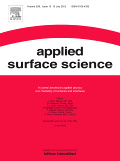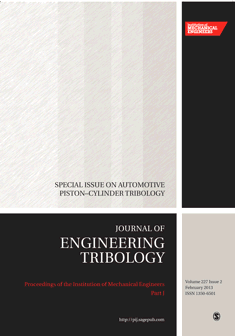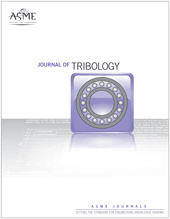
Surface Topography-Metrology and Properties
Scope & Guideline
Transforming surface characteristics into cutting-edge applications.
Introduction
Aims and Scopes
- Surface Metrology and Characterization:
The journal emphasizes the development and application of measurement techniques for assessing surface topography, including methods like atomic force microscopy (AFM), laser scanning, and digital holography. - Tribological Performance Analysis:
Research often investigates the tribological properties of materials, focusing on wear, friction, and lubrication under various conditions, including the influence of surface texture and coatings. - Material Development and Surface Engineering:
The journal reports on the creation and enhancement of materials, including coatings and composites, with tailored surface properties to improve mechanical and chemical performance. - Multiscale and Multiphysics Modeling:
Papers frequently employ computational modeling to understand the interactions at different scales—from atomic to macroscopic—helping to predict surface behavior under various operational conditions. - Sustainable and Eco-friendly Surface Treatments:
Recent publications highlight the development of environmentally friendly processes and materials, such as bio-inspired surfaces and green lubricants, reflecting a growing interest in sustainability.
Trending and Emerging
- Advanced Surface Texturing Techniques:
Research on novel surface texturing methods, such as laser texturing and micro/nano-structuring, is on the rise, focusing on enhancing tribological performance and functional properties. - Integration of Artificial Intelligence and Machine Learning:
There is a growing trend towards utilizing AI and machine learning techniques for predicting surface properties, optimizing manufacturing processes, and analyzing complex datasets related to surface metrology. - Sustainable Materials and Coatings:
Emerging studies emphasize the development of sustainable materials and eco-friendly coatings, reflecting an increasing awareness of environmental impacts and the need for greener technologies. - Multiscale Modeling Approaches:
The use of multiscale modeling to predict material behavior and performance at different scales is gaining traction, enabling more effective design and optimization of surface properties. - Bio-inspired and Smart Surfaces:
Research into bio-inspired surface designs and smart surfaces that respond to environmental stimuli is becoming a focal point, driven by applications in various fields, including biomedical engineering and self-cleaning technologies.
Declining or Waning
- Conventional Coating Techniques:
There appears to be a reduced frequency of studies focusing solely on traditional coating methods (e.g., simple electroplating) as researchers increasingly explore advanced techniques like plasma treatments and hybrid coatings. - Basic Tribology without Surface Engineering Considerations:
Research that examines tribological properties without considering surface engineering aspects, such as texture or advanced materials, is becoming less common as the field moves towards more integrated approaches. - Static Surface Characterization:
There is a noticeable decline in studies that focus exclusively on static measurements of surface properties, as dynamic and functional analyses are gaining more attention.
Similar Journals

Materials Physics and Mechanics
Unraveling the Complexities of Condensed MatterMaterials Physics and Mechanics is a pivotal journal dedicated to advancing the fields of condensed matter physics, materials science, mechanical engineering, and the mechanics of materials. Published by the Institute of Problems in Mechanical Engineering, Russian Academy of Sciences, this journal has established itself as a valuable resource since its inception, particularly from 2003 to 2004 and now continuously from 2009 to 2024. Although it currently holds a Q4 categorization in various disciplines, its contributions are critical to understanding and developing new materials and their applications in engineering. The journal provides insightful articles that explore the nuances of material properties, their behaviors under different conditions, and the physical principles governing these phenomena. Though it operates under a traditional publication model, the insights provided within its pages are invaluable to researchers, professionals, and students striving to push the boundaries of knowledge in the materials domain. Its ISSN numbers (1605-2730, E-ISSN 1605-8119) serve as a gateway to a wealth of scientific knowledge emanating from the Russian Federation, contributing to the global discourse in materials physics and mechanics.

China Surface Engineering
Exploring innovations in coatings and films.China Surface Engineering is a prominent academic journal dedicated to the field of materials science, with a specific emphasis on surfaces, coatings, and films. Published by the Chinese Association of Science and Technology (CAST), this journal serves as an essential platform for researchers, professionals, and students seeking to disseminate knowledge and advancements in surface engineering technologies and innovative applications. With its ISSN 1007-9289 and E-ISSN 1007-9289, it has established a distinct presence since its convergence in 2016, and continues to evolve in the rapidly advancing materials science landscape through to 2024. Although currently categorized in the Q4 quartile of its field, with a Scopus ranking of #103 out of 132 in Surfaces, Coatings and Films, the journal plays a critical role in contributing to the discourse surrounding surface treatment and modification, fostering advancements that are pivotal for industrial applications. As an avenue not only for knowledge transfer but also for collaboration among scientists worldwide, China Surface Engineering is crucial for anyone engaged in research or practical applications in this domain.

SURFACE REVIEW AND LETTERS
Connecting Scholars through Cutting-Edge ResearchSURFACE REVIEW AND LETTERS, published by WORLD SCIENTIFIC PUBL CO PTE LTD, is a pivotal journal in the fields of condensed matter physics, materials chemistry, and surfaces and interfaces. With an ISSN of 0218-625X and an E-ISSN of 1793-6667, this journal serves as a platform for cutting-edge research and innovative developments from 1996 to 2024. Despite its classification in the Q4 and Q3 quartiles for various categories in 2023, SURFACE REVIEW AND LETTERS emphasizes the importance of inter-disciplinary collaboration and the rapid dissemination of valuable insights, making it an essential resource for researchers and professionals eager to stay at the forefront of material science. Although currently lacking an open access option, the journal invites a wide range of submissions—fostering knowledge sharing among scholars and contributing to the advancement of the scientific community. Aspiring authors and readers will benefit from the opportunity to engage with diverse studies and methodologies, underscoring the journal's commitment to excellence in materials research.

Jurnal Tribologi
Connecting academia and industry through cutting-edge tribological insights.Jurnal Tribologi, published by the MALAYSIAN TRIBOLOGY SOC-MYTRIBOS, stands as a pivotal platform for research in the interdisciplinary field of tribology—focusing on the friction, wear, and lubrication of materials. Established in Malaysia and embracing Open Access since 2014, this journal serves a diverse readership and enables worldwide accessibility to cutting-edge research. With an ISSN of 2289-7232, it is indexed across various categories, achieving a commendable Q3 ranking in materials chemistry, mechanical engineering, and several other pertinent fields for 2023. The journal’s commitment to advancing knowledge in its domain is reflected in its circulation of valuable research findings and innovative methodologies, vital for both academic and industry professionals. Researchers, students, and practitioners alike will find Jurnal Tribologi an essential resource, advancing their understanding and application of tribological systems from 2019 to 2024 and beyond.

Surfaces
Transforming Perspectives on Material InteractionsSurfaces is an esteemed academic journal published by MDPI in Switzerland, operating as an open access platform since 2018. With an E-ISSN of 2571-9637, this journal focuses on the interdisciplinary advancements in the fields of chemistry, materials science, and physics, particularly in the domain of surfaces and interfaces. As a testament to its scholarly impact, Surfaces is ranked in the second quartile for multiple categories as of 2023, including Chemistry (miscellaneous), Materials Science (miscellaneous), Surfaces and Interfaces, as well as Surfaces, Coatings and Films, showcasing its relevance within these disciplines. Researchers and professionals seeking to disseminate and acquire knowledge on the latest innovations can benefit from the journal's rigorous peer-review process and commitment to quality, ensuring visibility and accessibility for current developments in surface technology and material interactions. With a growing archive from 2019 to 2024, Surfaces stands out as a vital resource for the academic community.

Tribology International
Shaping the Future of Mechanical Engineering Through Tribology.Tribology International, published by ELSEVIER SCI LTD, stands as a premier journal in the fields of tribology, mechanical engineering, and material science. With an impressive impact factor and ranking in the Q1 category across multiple disciplines such as Mechanical Engineering and Surfaces, Coatings and Films, this journal serves as a critical resource for researchers, professionals, and students looking to advance their knowledge and application of tribological principles. Established in 1972, Tribology International explores a wide array of topics, including friction, wear, and lubrication, making it indispensable for those dedicated to innovation in engineering and materials sciences. With its rigorous peer-review process and high visibility within the academic community, Tribology International is pivotal in disseminating influential research, fostering new ideas, and shaping the future of tribological research.

APPLIED SURFACE SCIENCE
Elevating Research in Surface ModificationsApplied Surface Science is a premier international journal published by Elsevier, focusing on the critical advancements in surface and interface science since its inception in 1984. With an impressive impact factor that places it in the Q1 category across multiple disciplines such as chemistry, condensed matter physics, and materials science, this journal serves as an essential platform for researchers and professionals eager to disseminate their findings and explore innovative applications within the realm of surfaces, coatings, and films. The journal's scope includes, but is not limited to, the study of surface modification, nanostructuring, and the fabrication of advanced materials, making it pivotal for those seeking to push the boundaries of applied sciences. It rates highly in Scopus rankings, standing at Rank #22 in condensed matter physics, Rank #5 in surfaces and interfaces, and Rank #13 in surfaces, coatings, and films, underscoring its vital contribution to the scientific community. While open access options are not available, the journal remains a significant resource for academics and industry experts alike, fostering a deeper understanding of surface phenomena and their applications in various technological fields.

INDUSTRIAL LUBRICATION AND TRIBOLOGY
Driving innovation in lubrication for optimal mechanical efficiency.INDUSTRIAL LUBRICATION AND TRIBOLOGY, published by EMERALD GROUP PUBLISHING LTD, is a distinguished journal dedicated to the fields of lubrication science and tribology, examining the fundamental aspects and innovative applications that enhance energy efficiency and mechanical performance in industrial settings since its inception in 1948. With an ISSN of 0036-8792, the journal is indexed in recognized databases, and its significant contributions have earned it a respectable Q3 category ranking in the disciplines of Energy, Mechanical Engineering, and Surfaces, Coatings, and Films. Researchers and professionals engaged in these fields will find valuable insights and cutting-edge research that drive innovation and improve the sustainability of industrial practices. While the journal does not currently offer open access options, it continues to be a pivotal platform for disseminating knowledge among scholars and practitioners. Its ongoing relevance in advancing tribological science highlights the critical role of lubrication in enhancing machine longevity and operational efficiency.

PROCEEDINGS OF THE INSTITUTION OF MECHANICAL ENGINEERS PART J-JOURNAL OF ENGINEERING TRIBOLOGY
Elevating industry standards with rigorous tribological research.PROCEEDINGS OF THE INSTITUTION OF MECHANICAL ENGINEERS PART J: JOURNAL OF ENGINEERING TRIBOLOGY is a premier scholarly publication dedicated to the intricate field of tribology, which encompasses the study of friction, wear, and lubrication in mechanical systems. Published by SAGE Publications Ltd, this journal aims to advance the scientific understanding and application of tribological principles across various industries, particularly in mechanical engineering. With an impressive impact factor and classified in the Q2 and Q3 quartiles in its respective categories, it provides a vital platform for disseminating innovative research and technical advancements. The journal spans over a rich timeline from 1994 to 2024, signifying its longstanding contribution to the academic community. It invites original research articles, comprehensive reviews, and insightful case studies that push the boundaries of existing knowledge and foster collaborative efforts among researchers, professionals, and students in the field. For those engaged in mechanical engineering and materials science, the journal offers unparalleled access to cutting-edge research that can inform and enhance practical applications in the industry.

JOURNAL OF TRIBOLOGY-TRANSACTIONS OF THE ASME
Driving Innovation in Mechanical EngineeringJOURNAL OF TRIBOLOGY-TRANSACTIONS OF THE ASME, published by the esteemed American Society of Mechanical Engineers (ASME), is a prominent peer-reviewed journal dedicated to the intricate study of tribological phenomena and their impact on mechanical systems. With an ISSN of 0742-4787 and an E-ISSN of 1528-8897, this journal has been a vital resource since its inception in 1967, covering significant developments in mechanical engineering, mechanics of materials, surfaces, and interfaces. Ranked in the Q2 quartile across multiple categories for 2023, including Mechanical Engineering and Surfaces and Interfaces, it reflects a respectable impact within the research community, with Scopus rankings highlighting its stature in various related fields. While it does not offer open access, its contributions to the understanding of wear, lubrication, and surface engineering are invaluable for researchers, professionals, and students alike, fostering advancements in both academic and industrial applications. With a commitment to disseminating high-quality research, this journal continues to be an essential platform for those seeking to push the boundaries of tribology and its applications.